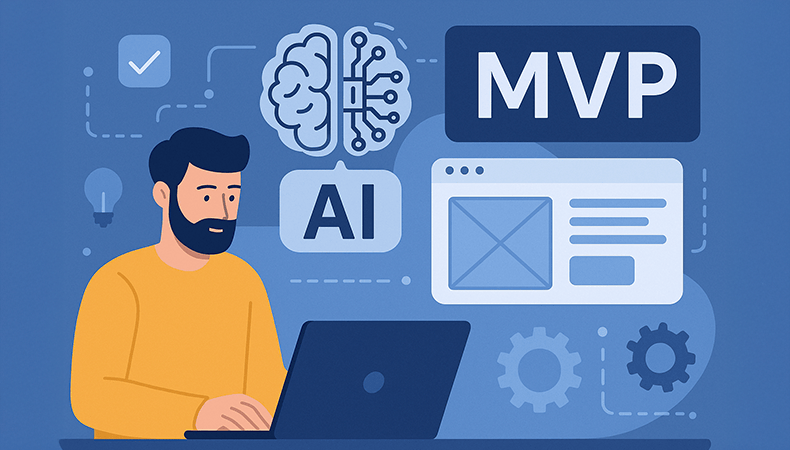
Build an AI MVP fast - that’s the new benchmark for ambitious startups in 2025.
MVP is the leanest version of your product that solves a real problem for real users. It’s not about launching a perfect app - it’s about learning fast, validating assumptions, and building momentum. MVP is designed to maximise learning while minimising development time and cost. For early-stage founders, it’s the smartest way to de-risk a new product idea.
In the past, MVP development often required 6 to 12 months, large teams, and significant upfront investment. But the landscape has changed dramatically.
Today, thanks to powerful AI technologies, the MVP development process has been compressed from months into weeks. What used to demand a team of developers, designers, and analysts can now be jumpstarted by a small team (or even a solo founder) using AI tools to automate coding, analyse user feedback, generate UI mockups, and validate market fit.
This isn’t just a trend - it’s a transformation. AI MVP building is now the preferred approach for modern founders who want to: launch faster, save money, test ideas in real-world conditions, attract early users and investors.
Whether you’re a tech-savvy CTO or a non-technical founder with a big idea, AI-powered MVPs give you a competitive edge in a crowded market.
At Patternica, we specialise in rapid MVP development using AI, tailored to your product vision and growth goals. We’ve helped startups across industries turn raw ideas into polished MVPs that secure funding, prove market demand, and scale confidently.
In this guide, we’ll walk you through how AI accelerates MVP development, the key tools and strategies to adopt, real-world success stories, and how we can help you build and launch your AI-powered MVP faster than ever before.
Why AI accelerates MVP development
The traditional MVP process (writing specs, hiring developers, manually coding features, gathering feedback, and iterating) used to take months, often draining precious runway before a startup even reached market validation. But AI is fundamentally changing that equation.
In 2025, founders no longer need to choose between speed and quality. With the rise of AI-driven development tools, it’s now possible to ideate, prototype, test, and iterate with unprecedented efficiency. From generating code and designing interfaces to analysing user behavior and predicting trends, AI removes friction at every stage of the MVP lifecycle.
Whether you're launching a SaaS platform, a mobile app, or a B2B product, AI injects intelligence, automation, and scale into the build process - enabling startups to move faster, make smarter decisions, and launch with confidence.
Here's why:
✓ Automation of repetitive tasks
You can generate prompts directly in ChatGPT to use in tools like Cursor or Replit.io - these AI-powered environments allow you to create, run, and iterate on projects in a single interface.
They save developers hours by handling boilerplate code, debugging suggestions, and test generation.
✓ Data-driven insights
AI tools can analyze vast amounts of data, including: market trends, user behavior, competitor features.
These insights help prioritise what to build and avoid wasting resources on features users don’t want.
✓ Rapid prototyping
No-code/low-code platforms like Bubble, CreateAppAI, or Adalo let non-technical founders prototype visual interfaces and test logic quickly.
With AI-enhanced builders, you can:
● Drag and drop app components
● Generate workflows based on user prompts
● Simulate product functionality in hours
✓ Cost-effectiveness and scalability
AI MVPs reduce development costs by cutting manual work and enabling smaller, more agile teams. Plus, with AI-injected workflows and modular infrastructure, scaling your product post-launch becomes significantly easier.
Do you want to build your own MVP?
Contact UsKey strategies for building an AI-powered MVP
Building aMVP with AI isn’t just about plugging in tools and hoping for speed. It requires a smart, focused strategy that aligns your product vision with real-world needs - while using AI to amplify your team’s capabilities.
In 2025, successful founders understand that the best AI-powered MVPs are not built by accident. They follow a streamlined process that leverages AI at every stage (ideation, prototyping, feature prioritization, testing, and iteration) while staying laser-focused on solving one core problem.
It’s not about building fast for the sake of speed; it’s about building the right thing, quickly, with evidence-driven insights and scalable architecture from the start.
Whether you're a non-technical founder or a technical lead managing a small dev team, these strategies will help you cut through the noise, avoid feature bloat, and deliver a clean, focused MVP that your users will actually want.
Here’s how to approach it in 2025:
1. Identify the core problem
Use research tools like Perplexity AI, ChatGPT, or Claude to gather information about user pain points and search trends. Analyse questions people ask, forums they frequent, and what existing tools lack.
This validation ensures you’re building a solution, not just another app.
2. Prioritise features with AI assistance
AI can analyse early user feedback, simulate user personas, and recommend which features to include or drop. Tools like Akkio and Hotjar integrated with AI help track user intent and highlight friction points.
Tip: Stick to the core value proposition. Feature creep kills MVPs.
3. Choose the right AI tools
Every startup stack is different, but in 2025, these tools are essential:
| Use case | Recommended tool |
| Brainstorming | ChatGPT, Notion AI |
| Coding | GitHub Copilot, Replit AI, Cursor |
| UI design | Uizard, Figma AI, Lovable |
| Feedback analysis | Qualetics, MonkeyLearn |
| Customer support | Intercom AI, Drift |
Cursor is becoming especially popular among developers thanks to its chat-like interface, where you can build and test code, iterate based on feedback, and refine your MVP inside a single environment.
For UI/UX design, Lovable is a user-friendly tool that works seamlessly with AI prompts. You can describe your layout in ChatGPT, generate a Lovable prompt, and instantly produce a usable design. From there, export it to GitHub or directly import it into Cursor to continue building.
Choose tools that match your skill set and team size. Integration speed matters more than feature count.
4. Test and iterate fast
Don’t build and hope. Use AI tools to:
● Track how users interact with your product (e.g., Mixpanel AI, Whatfix)
● Run A/B tests automatically
● Predict churn or engagement based on user sessions
This constant feedback loop helps refine your solution before scaling.
5. Ensure long-term scalability
Don’t box your MVP into a corner. Choose modular and serverless technologies (e.g., AWS Lambda, Firebase, Vercel) that let you scale once the idea is validated.
Use microservices and containerisation to keep your infrastructure light and ready to evolve.
Real-world examples
Base44 is one of the most compelling examples of how fast you can build and scale an AI-powered MVP today.
Maor Shlomo, the solo founder of Base44, built a fully functional app builder with AI in just six months. Using a natural language interface called “vibe coding,” users could describe what they wanted, and the platform would generate full-stack applications instantly. No large team. No external funding.
He started by chatting with ChatGPT to describe the product idea, used AI tools like Cursor to build features step by step, and iterated in real time using the same interface. UI design was generated with the help of AI prompts and integrated seamlessly into the codebase.
The result? Over 100,000 users, profitability, and a full acquisition by Wix for $80 million - all within months.
This is the new standard for what’s possible with AI MVP building in 2025.
How Patternica can help build your AI-powered MVP faster
At Patternica, we specialise in delivering MVPs powered by AI - ready to validate, pitch, and scale.
− Rapid development
We combine AI-powered tools with an agile approach to deliver functional MVPs in 4–6 weeks. From backend logic to UX design, automation speeds up every layer of the stack.
− Custom AI integrations
Need machine learning for personalisation? NLP for chat analysis? We integrate purpose-built AI solutions into your MVP to give it an edge.
− Data-driven strategy
Using real-time analytics, market intelligence, and synthetic data simulations, we guide product decisions that align with customer expectations and investor interest.
− Post-launch support
Once your MVP is validated, we help scale it (adding new features, optimising performance, and supporting integrations). You stay focused on growth, while we handle the tech.
− Proven track record
Patternica has helped early-stage startups attract funding, win customers, and pivot successfully - all through AI-driven MVPs built to deliver.
How AI tools work together step-by-step
Here’s a practical example of how non-technical and technical founders alike are building MVPs today:
- Start with ChatGPT: Describe your product idea and features. Ask it to generate a code prompt or prototype plan.
- Use Cursor or Replit.io: Take that prompt and generate the actual codebase. Run it, test it, and chat directly with the tool to refine your product.
- Design in Lovable: Ask ChatGPT to create a visual prompt for your landing page or interface. Paste it into Lovable to generate the design.
- Integrate everything: Upload your design to GitHub, pull it into Cursor, and continue testing or building logic.
- Iterate fast: Use built-in feedback tools or AI analytics to refine.
This AI-powered workflow reduces friction and allows even lean teams to move at startup speed.
Do you want to build your own MVP?
Contact UsChallenges and how to overcome them
While AI-powered MVP development offers unmatched speed and flexibility, it’s not without its challenges. Startups often assume that introducing AI will instantly streamline everything - but the reality is more nuanced. Poor data, the wrong tools, or over-automation can lead to delays, misalignment with user needs, or technical debt that’s hard to unwind later.
The key to success isn’t just using AI - it’s knowing how to use it wisely. Understanding the potential roadblocks early on helps founders build with confidence, avoid costly mistakes, and stay agile throughout the product lifecycle.
At Patternica, we’ve worked with startups across industries and have seen where AI MVP projects go wrong, and more importantly, how to get them back on track. Below are the most common pitfalls and how to proactively solve them before they stall your momentum.
Here's how to navigate them:
✓ Data quality
AI needs clean, relevant data to function. Startups often lack this. We recommend:
● Using synthetic datasets for training
● Leveraging public data (e.g., Kaggle, UCI Machine Learning Repository)
Patternica ensures data is pre-processed, normalized, and relevant to the MVP’s goal.
✓ Over-reliance on AI
Not everything can or should be automated. Design decisions, user empathy, and business strategy require human judgment.
We help teams strike the right balance between automation and human expertise.
✓ Scalability issues
Choosing the wrong architecture early can cost you down the road. We mitigate this by:
● Using modular tech stacks
● Designing with growth in mind from Day 1
Conclusion
AI is no longer a futuristic add-on - it’s the engine behind the next wave of startup innovation. In 2025, creating an MVP using AI isn’t just a shortcut; it’s a strategic advantage that can mean the difference between beating the market… or missing it entirely.
From idea validation and rapid prototyping to real-time analytics and continuous feedback loops, AI empowers founders to act faster, smarter, and more efficiently. You can test assumptions in days instead of months, iterate based on data (not guesswork) and launch with a clear understanding of what your users actually want.
By combining automation with insight, AI doesn’t just accelerate the MVP process - it elevates it.
But speed alone isn’t enough. You need clarity of purpose, the right tools, a scalable foundation, and a trusted partner who knows how to navigate the risks while amplifying the rewards.
That’s where Patternica comes in. We don’t just build MVPs - we help you launch smarter. Our team integrates AI across every phase of the process, from ideation to post-launch, ensuring your product is designed to grow, adapt, and succeed.
If you're ready to turn your startup idea into a real, working product (without the long timelines or bloated budgets) AI is your best ally.
FAQ
What happens after my MVP is built and validated?
Once validated, you can add more features, raise funding, or go to market. Patternica offers post-launch support and product scaling services.
What industries benefit most from AI-powered MVPs?
Fintech, eCommerce, EdTech, health, logistics, SaaS, and marketplaces all benefit from the agility and insights AI brings.
How does AI help validate an MVP’s market fit?
AI analyses user behavior and feedback in real-time, helping you adjust features and UX based on evidence - not guesses.
What are the benefits of using AI for MVP development?
Faster launch times, reduced development costs, smarter decisions, personalised experiences, and built-in scalability.
How long does it take to build an AI-powered MVP?
With the right tools and team, an AI MVP can be built in 4–6 weeks instead of 6+ months.
Can AI help reduce the cost of MVP development?
Yes. AI automates tasks, reduces human hours, and enables smaller teams to deliver more efficiently.


